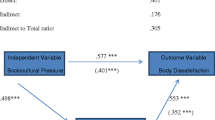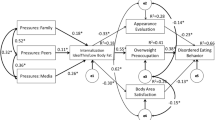Abstract
The study was conducted to examine the impact of sociocultural influences and the moderating role of self-esteem and negative affect on body dissatisfaction and body change strategies for both adolescent boys and girls. Surveys designed to assess body dissatisfaction, body change strategies to decrease weight and increase muscles, perceived sociocultural pressures to lose weight and increase muscles, self-esteem and negative affect were administered to 587 boys and 598 girls aged between 11 and 15 years. The majority of respondents were from Anglo-Australian backgrounds (83%) with the remainder being from Asian and European non-English-speaking backgrounds. The sociocultural influences were found to significantly predict body dissatisfaction and body change strategies for both boys and girls. However, in the case of boys, self-esteem was found to moderate the impact of the sociocultural influences in predicting body change strategies. It was primarily the boys with low self-esteem who were more affected by the sociocultural pressures whereas the girls were affected independently of their self-esteem. Negative affect was also found to play a moderating role on some of the sociocultural influences in predicting strategies to increase muscles. Both boys and girls with higher levels of negative affect were more likely to be affected by sociocultural messages directed at increasing muscles. The results from the present study demonstrate that as well as examining the direct influence of sociocultural pressures, it is also important to examine how these may be moderated by self-esteem and negative affect.
Similar content being viewed by others
REFERENCES
Aiken, L. S., & West, S. G. (1991). Multiple regression: Testing and interpreting interactions. Newbury Park, CA: Sage.
Andersen, A. E., & Di Domenico, L. (1992). Diet versus shape content of popular male and female magazines: A dose-response relationship to the incidence of eating disorders? International Journal of Eating Disorders, 11, 283–287.
Andersen, A. E.,& Holman, J. E. (1997). Males with eating disorders: Challenges for treatment and research. Psychopharmacology Bulletin, 33, 391–397.
Benedikt, R., Wertheim, E. H., & Love, A. (1998). Eating attitudes and weight-loss attempts in female adolescents and their mothers. Journal of Youth and Adolescence, 27, 43–57.
Button, E. J., Loan, P., Davies, J., & Sonuga-Barke, E. J. (1997). Self-esteem, eating problems, and psychological well-being in a cohort of schoolgirls aged 15–16: A Questionnaire and interview study. International Journal of Eating Disorders, 21, 39–47.
Colder, C. R., & Chassin, L. (1997). Affectivity and impulsivity: Temperament risk for adolescent alcohol involvement. Psychology of Addictive Behaviors, 11, 83–97.
Cusimano, D. C., & Thompson, J. K. (1997). Body image and body shape ideals in magazines: Exposure, awareness, and internalization. Sex Roles, 37, 701–721.
Edwards, S., & Launder, C. (2000). Investigating muscularity concerns in male body image: Development of the Swansea Muscularity Attitudes Questionnaire. International Journal of Eating Disorders, 28, 120–124.
Furnham, A., & Calman, A. (1998). Eating disturbance, self-esteem, reasons for exercising and body weight dissatisfaction in adolescent males. European Eating Disorders Review, 6, 58–72.
Gillett, J., & White, P. G. (1992). Male bodybuilding and the reassertion of hegemonic masculinity: A Critical feminist perspective. Play and Culture, 5, 358–369.
Harrison, K., & Cantor, J. (1997). The relationship between media consumption and eating disorders. Journal of Communication, 47, 40–67.
Hill, A. J., & Franklin, J. A. (1998). Mothers, daughters and dieting: Investigating the transmission of weight control. British Journal of Clinical Psychology, 37, 3–13.
Keel, P. K., Fulkerson, J. A., & Leon, G. R. (1997). Disordered eating precursors in pre-and early adolescent girls and boys. Journal of Youth and Adolescence, 26, 203–216.
Killen, J.D., Taylor, C.B., Hayward, C., Wilson, D. M., Haydel, K. F., Hammer, L.D., Simmonds, B., Robinson, T. N., Litt, I., Varady, A.,& Kraema, H. (1994). Pursuit of thinness and onset of eating disorder symptoms in a community sample of adolescent girls: A three-year prospective analysis. International Journal of Eating Disorders, 16, 227–238.
Koenig, L. J., & Wasserman, E. L. (1995). Body image and dieting failure in college men and women: Examining links between depression and eating problems. Sex Roles, 32, 225–249.
Lawrence, C. M., & Thelen, M. H. (1995). Body image, dieting, and self-concept: Their relation in Afro-American and Caucasian children. Journal of Clinical Child Psychology, 24, 41–48.
Leal, L., Weise, S. M., & Dodd, D. K. (1995). The relationship between gender, symptoms of bulimia, and tolerance for stress. Addictive Behaviors, 20, 105–109.
Leary, M. R., Schreindorfer, L. S., & Haupt, A. L. (1995). The role of self-esteem in emotional and behavioral problems: Why is low self-esteem dysfunctional? Journal of Social and Clinical Psychology, 14, 297–314.
Leit, R. A., Pope, H. G., & Gray, J. J. (2001). Cultural expectations of muscularity in men: The evolution of playgirl centerfolds. International Journal of Eating Disorders, 29, 90–93.
Leon, G. R., Fulkerson, J. A., Perry, C. L., Keel, P. K., & Klump, K. L. (1999). Three to four year prospective evaluation of personality and behavioral risk factors for later disordered eating in adolescent girls and boys. Journal of Youth and Adolescence, 28, 181–196.
Lovibond, P. F., & Lovibond, S. H. (1995). The structure of negative emotional states: Comparison of the Depression Anxiety Scales (DASS) with the Beck Depression and Anxiety Inventories. Behaviour Research and Therapy, 33, 335–343.
Marsh, H.W. (1990). Self-Description Questionnaire-II.Sydney: University ofWestern Sydney.
McCabe, M. P., & Ricciardelli, L. A. (2000). How different are adolescent boys and adolescent girls in the feedback they receive from parents, peers, and the media? Manuscript submitted for publication.
McCabe, M. P., & Ricciardelli, L. A. (in press). The development of the Perceived Sociocultural Influences on Body Image and Body Change Questionnaire. International Journal of Behavioral Medicine.
McCreary, D. R.,& Sasse, D.K. (2000).Anexploration of the drive for muscularity in adolescent boys and girls. Journal of American College of Health, 48, 297–304.
Mishkind, M. E., Rodin, J., Silberstein, L. R.,& Striegel-Moore, R.H. (1986). The embodiment of masculinity: Cultural, psychological, and behavioral dimensions. American Behavioral Scientist, 29, 545–562.
Mukai, T. (1996). Mothers, peers, and perceived pressure to diet among Japanese adolescent girls. Journal of Research on Adolescence, 6, 309–324.
Nassor, C. M., Hodges, P., & Ollendick, T. (1992). Self-concept, eating attitudes, and dietary patterns in young adolescent girls. The School Counsellor, 39, 338–343.
Nemeroff, C. J., Stein, R. I., Diehl, N. S., & Smilack, K. M. (1994). From the Cleavers to the Clintons: Role choices and body orientation as reflected in magazine article content. International Journal Eating Disorders, 16, 167–176.
Neumark-Sztainer, D., Story, M., Falkner, N. H., Beuhring, T., & Resnick, M. D. (1999). Sociodemographic and personal characteristics of adolescents engaged in weight loss and weight/muscle gain behaviors: Who is doing what? Preventative Medicine, 28, 40–50.
Nolen-Hoeksema, S., & Girgus, J. S. (1994). The emergence of gender differences in depression during adolescence. Psychological Bulletin, 115, 424–443.
Paxton, S. J., Schutz, H. K., Wertheim, E. H., & Muir, S. L. (1999). Friendship cliques and peer influences in body image concerns, dietary restraint, extreme weight-loss behaviors, and binge eating in adolescent girls. Journal of Abnormal Psychology, 108, 255–266.
Pike, K. M.,& Rodin, J. (1991). Mothers, daughters, and disordered eating. Journal of Abnormal Psychology, 100, 198–204.
Pingitore, R., Spring, B.,& Garfield, D. (1997). Gender differences in body satisfaction. Obesity Research, 5, 402–409.
Pope, H. G., Olivardia, R., Gruber, A., & Borowiecki, J. (1999). Evolving ideals of male body image as seen through action toys. International Journal of Eating Disorders, 26, 65–72.
Ricciardelli, L. A., & McCabe, M. P. (2000). Psychometric evaluation of the Body Image and Body Change Inventory:Anassessment instrument for adolescent boys and girls. Manuscript submitted for publication.
Ricciardelli, L. A., McCabe, M. P.,& Banfield, D. (2000). Body image and body change methods in adolescent boys: Role of parents, friends, and the media. Journal of Psychosomatic Research, 49, 189–197.
Rosenberg, M. (1979). Conceiving the self. New York: Basic Books.
Spitzer, B. L., Henderson, K. A., & Zivian, M. T. (1999). Gender differences in population versus media body sizes: A comparison over four decades. Sex Roles, 40, 545–565.
Steen, S. N., Wadden, T. A., Foster, G. D., & Andersen, R. E. (1996). International Journal of Eating Disorders, 20, 281–286.
Stice, E. (1994). Review of the evidence for a sociocultural model of bulimia nervosa and an exploration of the mechanisms of action. Clinical Psychology Review, 16, 633–661.
Stice, E., & Shaw, H. E. (1994). Adverse effects of the media portrayed thin-ideal on women and linkages to bulimic symptomatology. Journal of Social and Clinical Psychology, 13, 288–308.
Stormer, S. M., & Thompson, J. K. (1996). Explanations of body image disturbance: A test of maturational status, negative verbal commentary, social comparison, and sociocultural hypotheses. International Journal of Eating Disorders, 19, 193–202.
Striegel-Moore, R. H., Silberstein, L. R., & Rodin, J. (1986). Toward an understanding of risk factors for bulimia. American Psychologist, 41, 246–263.
Taylor, C. B., Sharpe, T., Shisslak, C., Byrson, S., Estes, L. S., Gray, N., McJnight, K. M., Crago, M., Kraerner, H. C., & Killen, J. D. (1998). Factors associated with weight concerns in adolescent girls. International Journal of Eating Disorders, 24, 31–42.
Thompson, J. K., Coovert, M. D., Richards, K. J., Johnson, S., & Cattarin, J. (1995). Development of body image, eating disturbance, and general psychological functioning in female adolescents: Covariance structure modeling and longitudinal investigations. International Journal of Eating Disorders, 18, 221–236.
Thompson, J. K., & Heinberg, L. J. (1999). The media's influence on body image disturbance and eating disorders:We've reviled them, now can we rehabilitate them. Journal of Social Issues, 55, 339–353.
Vincent, M. A.,& McCabe, M. P. (2000a). Gender differences among adolescents in family, and peers influences on body dissatisfaction, weight loss, and binge eating behaviors. Journal of Youth and Adolescence, 29, 205–221.
Vincent, M. A., & McCabe, M. P. (2000b). Gender differences in the role of biodevelopmental and psychological factors in the expression of body dissatisfaction and disordered eating. Manuscript submitted for publication.
Wertheim, E. H., Mee, V., & Paxton, S. J. (1999). Relationships among adolescent girls' eating behaviors and their parents' weight-related attitudes and behaviors. Sex Roles, 41, 169–187.
Wertheim, E. H., Paxton, S. J., Schultz, H. K.,& Muir, S.L. (1997).Why do adolescent girls watch their weight? An interview study examining sociocultural pressures to be thin. Journal of Psychosomatic Research, 42, 345–355.
Author information
Authors and Affiliations
Corresponding author
Rights and permissions
About this article
Cite this article
Ricciardelli, L.A., McCabe, M.P. Self-Esteem and Negative Affect as Moderators of Sociocultural Influences on Body Dissatisfaction, Strategies to Decrease Weight, and Strategies to Increase Muscles Among Adolescent Boys and Girls. Sex Roles 44, 189–207 (2001). https://doi.org/10.1023/A:1010955120359
Issue Date:
DOI: https://doi.org/10.1023/A:1010955120359




